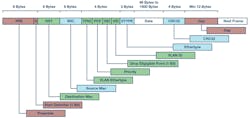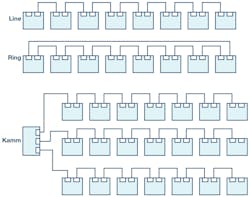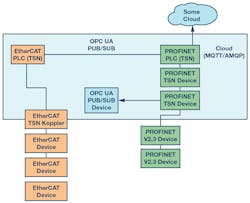What’s the Difference Between Ethernet and Time-Sensitive Networking?
Download this article in PDF format.
These days, anyone working in industrial communications is bound to come up against the topic of time-sensitive networking (TSN). TSN will definitely get here. The only thing that still must be clarified is when and in what form. However, even today, its advantages for industrial communications aren’t always clear.
History
Ethernet was introduced to offices in the early 1980s and quickly became very popular due to its high throughput of (at that time) a sensational 10 Mb/s. However, this Ethernet wasn’t practical for real-time applications because it used a common medium known as a party line. Collisions occurring at high utilization rates caused problems in office settings.
1. In this Ethernet frame, data fields relevant to TSN data-flow identification are shown in green.
In the next step of its development, collisions were eliminated through the introduction of switched networks. In addition, with quality of service (QoS), Ethernet datagram prioritization was introduced (Fig. 1).
For industrial applications, guaranteed latency is particularly important. Despite QoS, standard Ethernet as used in offices can only guarantee latencies up to a certain point, especially with high network utilization.
There are several reasons for this, with the main issues being the store-and-forward strategy commonly used in commercial multiport switches and the fact that it’s impossible to reserve bandwidth.
Store and forward means that a switch receives a complete datagram before forwarding it. This has advantages in terms of processing in the switch, but it also brings potential problems that can negatively impact latency and reliability:
- When going through a switch, a datagram is delayed by an amount depending on its length. If switches are cascaded, the effect is magnified.
- Because a switch doesn’t have an infinite storage capacity, it can reject datagrams if the network is experiencing overutilization (too much traffic); this means that datagrams—even those given higher priority—can simply be lost.
- Long datagrams can block a port for relatively long times.
Switch cascading posed a challenge in industrial environments right from the start. Apart from the star topology used in the IT field, line, ring, and tree topologies are frequently used in automation (Fig. 2). These adapted topologies significantly reduce Ethernet installation wiring requirements and costs. Hence, in industry, two-port switches employing a cut-through strategy are integrated into field devices. Cut-through means that datagrams are forwarded before being completely received.
2. Among the frequently used topologies in automation are line and ring.
One Size Fits It All: Industrial Ethernet up to Now
Because classic Ethernet did not have sufficient capabilities for bandwidth reservation, automation experts began developing their own Ethernet extensions in 2000. However, the paths they took differed greatly. Differentiation is made between the following approaches:
- Protocols using Ethernet as a transport medium for a fieldbus. These protocols claim complete control over the Ethernet medium for themselves. Classic TCP/IP communications are only possible in piggyback style via the fieldbus (EtherCAT and POWERLINK) or through a channel assigned by the fieldbus (Sercos). Bandwidth control is firmly in the hands of the fieldbus.
- Protocols that guarantee bandwidth reservation through a time slicing procedure on the Ethernet (Fig. 3). PROFINET IRT should be mentioned here. IRT enables hard deterministic real-time data transmission on the same cable on which soft real-time or background traffic is operated. A precise timing model for the transmission paths is necessary for planning of the time slices.
- Protocols based on sharing of the Ethernet cable. These protocols use QoS and are at home in factory- and process-automation applications. PROFINET RT and EtherNet/IP are noteworthy examples. These protocols are limited to the range of soft real time (cycle time ≥ 1 ms).
For these standards, special hardware support and, thus, special ASICs are needed. Because PROFINET RT and EtherNet/IP are also based on the embedded two-port switch with cut-through, they’re also not exempt here.
3. PHYs, cables, and switches contribute to delays in data transmission. This must be considered with the time slot method (PROFINET IRT and TSN time aware shaper (TAS).
Enter TSN
With TSN, extensions for standard Ethernet in accordance with IEEE 802.1 that break free of past limitations have successfully been developed. Thus, there’s now a standardized layer 2 in the ISO 7-layer model with upward compatibility to the previous Ethernet and hard real-time capability. With 802.1AS-rev, TSN also defines an interoperable, uniform method for synchronizing distributed clocks in the network.
Because best effort communication always takes place with TSN, the common use of a cable is possible for hard real-time applications, as well as all other applications (web server, SSH, etc.). TSN is not dissimilar to PROFINET IRT in that regard, and it offers comparable performance.
What’s new with TSN is the need for more extensive network configuration. Centralized or decentralized configuration is possible. Both types of configuration are currently being discussed and implemented. Interoperability between the two configuration mechanisms is a future development goal.
Practical Advantages
The most common answer is that with a larger market, less expensive network interfaces also appear on the market. After all, TSN will also be found in building automation and the automotive industry in the future. As a matter of fact, the market for embedded TSN solutions is expected to be significantly bigger than the current market for all industrial Ethernet solutions put together.
The greatest technical advantage of TSN over previous industrial Ethernet methods is its scalability. Unlike current industrial networks, TSN was not defined for a specific transmission rate. TSN can be used for 100 Mb/s just as for 1 Gb/s, 10 Mb/s, or 5 Gb/s.
It also enables topologies to be better optimized because now adapted data rates can be selected for various segments. Whether it’s Gb/s, 100 Mb/s, or 10 Mb/s, a unified layer 2—IEEE802.1/TSN—is used.
A uniform network infrastructure also helps personnel tasked with setting up and maintaining the network. That’s because, thanks to TSN, solutions can now be used in sectors other than automation: building, process, and factory automation, as well as energy distribution.
This prompts the next advantage—the training factor. TSN is already a topic at many universities, mostly in the research stage. However, technical and vocational colleges are already showing interest in this topic. It can be safely said that TSN will become basic knowledge for engineers, technicians, and skilled workers. Retraining for different fieldbuses will no longer be necessary.
Brownfield, or What Will Happen to Today’s Protocols?
In nearly all TSN-related working groups, there’s recurring theme: How to safeguard the transition to TSN and the supply to existing installations, such as Brownfield applications?
On all sides, emphasis is being placed on making it possible for customers to easily and smoothly transition to TSN. It can already be said today that the existing industrial Ethernet protocols aren’t just going to vanish overnight. On the contrary, anyone using PROFINET, EtherNet/IP, EtherCAT, or a similarly widespread industrial Ethernet protocol today can safely assume that he or she will also be able to operate networks with these protocols— and receive support and replacement parts—in 10 years’ time.
4. The TSN segment is combined with PROFINET and EtherCAT.
All industrial Ethernet organizations provide models that describe how existing plants can cooperate with new TSN-based devices. The interface to the existing industrial network is made by a gateway (Sercos), with a coupler (EtherCAT), or without any special hardware (PROFINET RT) (Fig. 4). In particular, PROFINET and EtherNet/IP plan to make their complete protocols available right on TSN as layer 2. This makes stepwise transition to TSN possible.
Conclusion
TSN will be found everywhere in new installations, as well as in the form of islands or segments introduced incrementally into existing installations.
However, with TSN, there will be new players in the industrial Ethernet field. OPC UA with new transport protocol PUB/SUB, in conjunction with TSN, is already a competitor to classic protocols. For the manufacturers of field devices, this means that the classic industrial Ethernet solutions, as well as TSN and the new players, must be supported.
Volker E. Goller, a systems applications engineer with Analog Devices.
About the Author
Volker E. Goller
Systems Applications Engineer
Volker E. Goller, a systems applications engineer with Analog Devices, has over 30 years of experience with a diverse set of industrial applications ranging from complex motion control and embedded sensors to time-sensitive-networking technology. A software developer by trade, Volker has developed a wide variety of communication protocols and stacks for wireless and wired applications while actively engaging in fielding new communication standards through his involvement with leading industry organizations.





